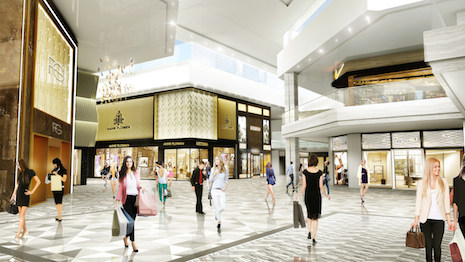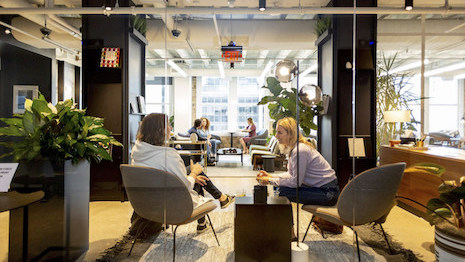 Macerich's Scottsdale Fashion Square is one of the malls getting a co-working tenant. Image credit: Macerich
Macerich's Scottsdale Fashion Square is one of the malls getting a co-working tenant. Image credit: Macerich
As mall operators contend with vacancies and falling foot traffic, a new report finds that the simultaneous rise of remote work and non-traditional offices could usher in new opportunities for shopping centers. A JLL study of co-working spaces at malls projects that the space dedicated to these alternative offices at shopping centers will grow by 25 percent through 2023. Co-working spaces particularly target retailers in neighborhoods with high average income levels, making them ideal partners for upscale malls.
"Co-working provides a great opportunity for mall owners to backfill any vacancies they have in their centers," said Taylor Coyne, research manager at JLL Retail, Los Angeles. "Not only does it do the obvious of filling vacant space but it automatically provides a new shopper base for all the other surrounding stores."
Commerce meets co-working Bricks-and-mortar retail is facing a number of challenges courtesy of ecommerce and changing consumer behavior. Shoppers are buying less as they seek experiences over things. Meanwhile, availability of online shopping has moved some purchasing out of the store, causing struggles for physical retail. As a result, many malls are turning to alternative tenants such as grocery stores and gyms. Another popular mixed-use addition is office space. In particular, co-working is seeing an increased interest from mall operators. JLL found that today, the 75 co-working tenants it was able to identify take up more than 1 million square feet. These also tend to be in affluent areas, with the average income of residents that live within three square miles of a co-working space coming in around $100,000. Co-working companies such as Industrious are entering malls. Image credit: Macerich
Co-working spaces also tend to be placed in locations that are easily walkable. About one-fifth take spaces in storefront retail, while another fifth occupy shopping centers.
Along with solving the problem of vacancies, co-working gives malls guaranteed daily foot traffic. While boosting business to existing retailers, this can also make a particular mall more attractive to potential retail tenants.
JLL’s report examined four different types of co-working spaces.
One format is a “retail launchpad,” which includes incubators or demonstration spaces for startups to reach shoppers. Of the four different co-working formats, these target neighborhoods with the most affluent audiences, with an average household income of almost $130,000.
The Mall at Chicago’s Water Tower Place is one center that is opening this style of co-working space. This will include merchandising and event spaces, allowing shoppers to interact with the people behind brands or tech companies.
Co-working companies such as Industrious are entering malls. Image credit: Macerich
Co-working spaces also tend to be placed in locations that are easily walkable. About one-fifth take spaces in storefront retail, while another fifth occupy shopping centers.
Along with solving the problem of vacancies, co-working gives malls guaranteed daily foot traffic. While boosting business to existing retailers, this can also make a particular mall more attractive to potential retail tenants.
JLL’s report examined four different types of co-working spaces.
One format is a “retail launchpad,” which includes incubators or demonstration spaces for startups to reach shoppers. Of the four different co-working formats, these target neighborhoods with the most affluent audiences, with an average household income of almost $130,000.
The Mall at Chicago’s Water Tower Place is one center that is opening this style of co-working space. This will include merchandising and event spaces, allowing shoppers to interact with the people behind brands or tech companies.
 Chicago's Water Tower Place gives entrepreneurs retail space through co-working. Image credit: Cowork at the Mall
A more common co-working format is “telework spaces,” which target corporate workers as well as creatives. JLL notes that some of these can total 30,000 square feet, positioning them to potentially the place of larger retailers that have moved out.
Geared toward entrepreneurs, “business boosters” support workers with services such as classes and mentors.
“Creative coalitions” offer spaces for those in artistic fields, such as dark rooms and 3D printers. These tend to be appealing to millennials, with spaces typically located in urban environments.
While much of the co-working spaces studied are based in walkable destinations, JLL sees a potential for these offices in suburban malls, particularly as millennials move into homes.
Chicago's Water Tower Place gives entrepreneurs retail space through co-working. Image credit: Cowork at the Mall
A more common co-working format is “telework spaces,” which target corporate workers as well as creatives. JLL notes that some of these can total 30,000 square feet, positioning them to potentially the place of larger retailers that have moved out.
Geared toward entrepreneurs, “business boosters” support workers with services such as classes and mentors.
“Creative coalitions” offer spaces for those in artistic fields, such as dark rooms and 3D printers. These tend to be appealing to millennials, with spaces typically located in urban environments.
While much of the co-working spaces studied are based in walkable destinations, JLL sees a potential for these offices in suburban malls, particularly as millennials move into homes.
"Retail spaces could benefit from a variety of co-working spaces, but retail launchpads may have the greatest synergy with top-tier malls due to the fact that they are concentrated in areas with high incomes," Ms. Coyne said. "Retail launchpads, co-working companies that specifically target retail startups, are hoping to attract shoppers with spending power that are interested in testing out the newest concepts in retail and technology."
Putting retail to work As retailers downsize to more cost-effective, productive store footprints, co-working is taking over as a prime retail tenant. For instance, mall owner and operator Macerich is looking to drive traffic to its shopping centers through a partnership with co-working company Industrious. This alliance will bring Industrious’ office concept to multiple properties, with the first location opening at Macerich’s Scottsdale Fashion Square. Malls are increasingly becoming mixed-use properties as developers seek to bring people in for more than shopping (see story). Retail group Hudson’s Bay Company similarly entered a global, multi-faceted strategic relationship with communal workspace network WeWork. One of retail’s primary stressors is the operational cost associated with bricks-and-mortar storefronts now that so much of the market share as moved online. HBC’s strategic partnership with WeWork and Rhône Capital, an affiliate of WeWork Property Advisors, hopes to lessen the burden by maximizing the productivity and value of the retailer’s global real estate assets while also positioning its brands as being on the forefront of experiential retailing. Lord & Taylor’s flagship will maintain current operations throughout the entire 11-floor building through the end of the 2018 holiday season. After, WeWork will convert the building into its New York headquarters and office space. At that point, Lord & Taylor’s floorplan will be redesigned and scaled down to a selling floor of approximately 150,000 square feet (see story). Aside from malls, there is an opportunity for co-working in streetfront retail spaces."Spaceous in Boston is a great example of this," Ms. Coyne said. "The creators of Spaceous saw rising storefront vacancies in urban retail corridors in Boston and realized there was an opportunity to take those spaces and create workspaces and storefronts for artists to create and sell their work.
"This gives much-needed space to artists and exposes them to shoppers that are already drawn to that location for the surrounding retail," she said.
"Twenty percent of the co-working spaces that we looked at are located in streetfront retail properties. For those companies, it’s clear that being in urban areas with high foot traffic is key to their success, so we should expect to see more co-working concepts locating in urban retail corridors along with traditional retail tenants."
